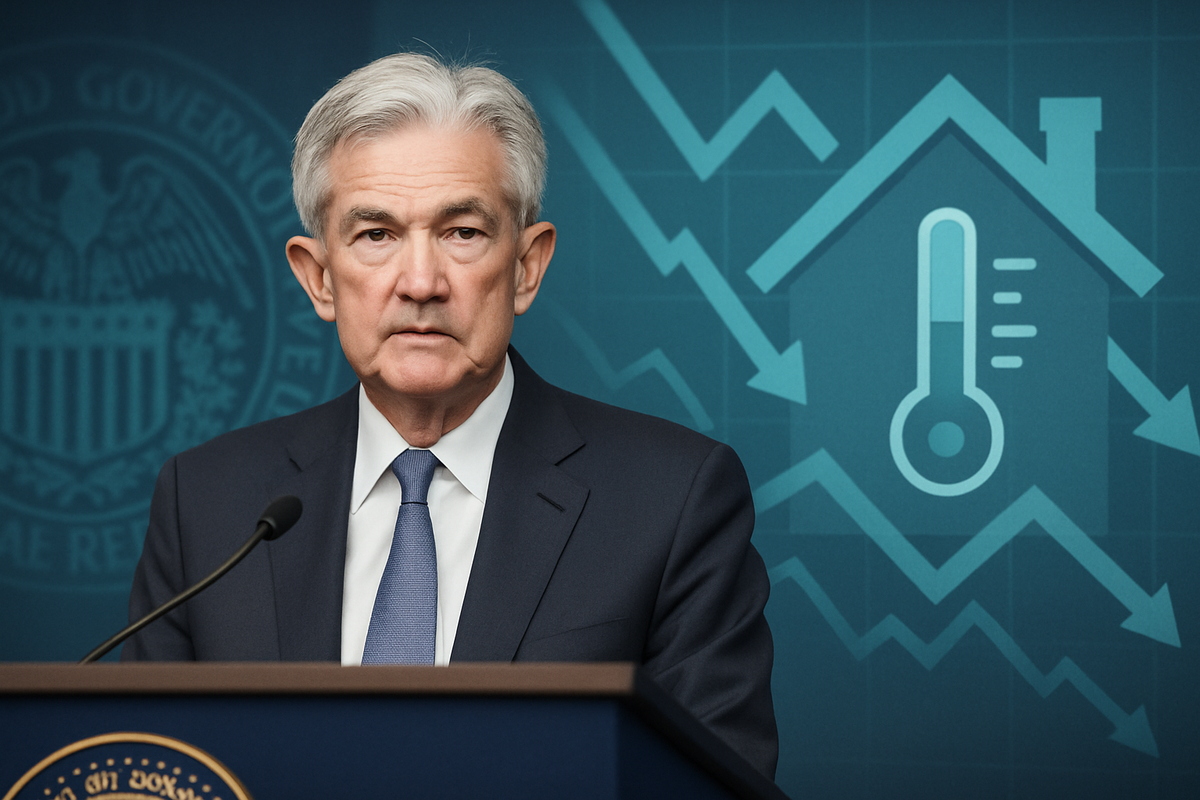Financial News
Federal Reserve Governor Stephen Miran Signals Aggressive Rate Cuts Amid "Significant Disinflation" in Housing

Washington D.C. – October 16, 2025 – Federal Reserve Governor Stephen Miran today delivered a pivotal address, signaling the central bank's readiness for aggressive interest rate cuts in the near future. The pronouncement, made on October 16, 2025, has sent ripples of optimism through financial markets, as investors digest the prospect of a significantly more dovish monetary policy. Governor Miran's rationale hinges critically on what he termed "significant disinflation" within the housing sector, a development he believes provides ample room for the Fed to pivot towards stimulating economic growth and employment.
This unexpected yet eagerly anticipated shift marks a potential turning point for the U.S. economy, suggesting that the era of tight monetary policy may be drawing to a close sooner than many anticipated. The immediate implication is a likely surge in equity markets, particularly in interest-rate-sensitive sectors, and a corresponding drop in bond yields as investors price in a lower future path for the federal funds rate.
A New Era of Dovishness: Miran's Stance and Housing's Influence
Governor Stephen Miran, who was sworn into office on September 16, 2025, has quickly established himself as a prominent dovish voice within the Federal Open Market Committee (FOMC). Notably, at his inaugural FOMC meeting, he stood as the sole dissenter, advocating for a more aggressive 50-basis-point rate cut against the majority's decision for a 25-basis-point reduction. His current signal for aggressive cuts is rooted in a deep conviction that "significant disinflation" in the housing market is underway, providing the central bank with the necessary flexibility to ease monetary conditions without reigniting broader inflationary pressures.
Housing, which constitutes approximately 36% of the Consumer Price Index (CPI), plays a disproportionately large role in overall inflation metrics. Miran's assertion of a "material decline in services inflation driven by housing" suggests that he foresees a sustained slowdown in the rate of price increases within this critical sector. This disinflationary trend, distinct from outright deflation, indicates that the rapid cooling of housing costs is effectively curbing a major component of inflation, thereby allowing the Fed to shift its focus.
Beyond rate cuts, Governor Miran has also championed an end to quantitative tightening (QT) "in the not too distant future," questioning the marginal benefits of further balance sheet reductions. If his views gain broader traction within the Fed, future policy could encompass not only a series of rapid rate reductions but also a halt or even reversal of the balance sheet runoff, injecting further liquidity into the financial system. Such a comprehensive dovish pivot would underscore a significant reorientation of the Fed's policy, prioritizing growth and employment against what it perceives as receding inflationary threats.
Initial market reactions have been swift and largely positive. Equity futures surged following Miran's comments, with technology and real estate sectors poised for significant gains. Bond yields plummeted across the curve as investors adjusted their expectations for future interest rates. The U.S. dollar, conversely, showed signs of depreciation against major currencies, a typical response to anticipated rate differentials. Commodity markets, often inversely correlated with the dollar, saw a general uplift.
Companies Poised to Win or Lose in a Lower-Rate Environment
A shift towards aggressive rate cuts by the Federal Reserve carries profound implications for various sectors and individual companies within the financial markets. The prospect of cheaper borrowing costs and increased liquidity will undoubtedly create winners and losers.
Potential Winners:
- Housing and Real Estate: Companies directly tied to the housing market stand to benefit significantly. Homebuilders like D.R. Horton (NYSE: DHI) and Lennar (NYSE: LEN) could see a surge in demand as lower mortgage rates make homeownership more affordable. Real estate investment trusts (REITs), such as Prologis (NYSE: PLG), which often rely on debt financing for acquisitions and developments, would also experience reduced capital costs, potentially boosting their profitability and expansion capabilities.
- Technology and Growth Stocks: The technology sector, characterized by companies with high growth potential and often relying on future earnings, typically thrives in a low-interest-rate environment. Lower discount rates applied to future cash flows make these companies' valuations more attractive. Giants like Apple (NASDAQ: AAPL), Microsoft (NASDAQ: MSFT), and Nvidia (NASDAQ: NVDA) could see renewed investor interest and upward pressure on their stock prices.
- Consumer Discretionary: With reduced borrowing costs, consumers may feel more confident in taking on debt for larger purchases, leading to increased spending. Companies in the consumer discretionary sector, including retailers like Amazon (NASDAQ: AMZN) or hospitality giants like Starbucks (NASDAQ: SBUX), could experience a boost in sales and profitability.
Potential Losers:
- Banks and Financial Institutions: While a strong economy generally benefits banks, aggressive rate cuts can compress net interest margins (NIMs) – the difference between what banks earn on loans and pay on deposits. Major financial institutions like JPMorgan Chase (NYSE: JPM) and Bank of America (NYSE: BAC) could see their profitability come under pressure if loan rates fall faster than deposit rates.
- Value and Dividend Stocks: In an environment where risk-free returns (like government bond yields) are lower, growth stocks often become more appealing relative to traditional value or high-dividend-paying stocks. Investors might rotate out of defensive positions into higher-growth opportunities, potentially causing these stocks to lag.
- Sectors Sensitive to a Weaker Dollar: While a weaker dollar can boost exports, companies heavily reliant on imports might face higher costs, though the overall impact can be complex and depends on hedging strategies and global supply chains.
Wider Significance: A Policy Reset and Global Ripples
Governor Miran's aggressive dovish signal signifies a potential policy reset for the Federal Reserve, shifting its primary focus from inflation containment, which dominated the past few years, to actively stimulating economic growth and employment. This move suggests that the Fed believes the battle against inflation, particularly through the lens of housing disinflation, has largely been won, or at least is well on its way to being resolved.
The ripple effects of such a significant policy pivot could extend globally. Other major central banks, facing similar economic headwinds or seeking to maintain competitive currency valuations, might be compelled to follow suit with their own easing measures. This could lead to a coordinated global monetary easing cycle, potentially boosting international trade and investment. However, it could also exacerbate capital flows into emerging markets, creating both opportunities and risks for these economies.
Historically, periods of aggressive rate cuts have often followed economic downturns or periods of significant financial stress. While the current situation is framed around disinflation rather than a crisis, the proactive nature of Miran's proposal draws parallels to earlier easing cycles, such as those seen post-2008 or in the early 2000s. However, the specific emphasis on "housing disinflation" as the primary catalyst makes this particular easing cycle unique, highlighting the evolving dynamics of inflationary pressures in the modern economy. Regulatory bodies will also be keenly watching for any signs of financial instability, as prolonged periods of extremely low rates can sometimes foster asset bubbles or encourage excessive risk-taking within the financial system.
What Comes Next: Navigating the New Monetary Landscape
The immediate aftermath of Governor Miran's signal will likely be characterized by heightened market volatility as investors and analysts fully digest the implications of this potential policy shift. Short-term, we can expect increased speculation regarding the timing and magnitude of future rate cuts, with every subsequent Fed speaker's comments being scrutinized for further dovish cues. Companies will begin to re-evaluate their capital expenditure plans, and consumers may adjust their borrowing and spending habits in anticipation of a lower interest rate environment.
In the long term, a sustained period of lower interest rates, if implemented aggressively, could foster a robust economic recovery, particularly if the disinflationary trends hold. This might lead to renewed business investment, job creation, and a healthier housing market. However, challenges could emerge if the disinflation proves temporary or if the economy overheats, potentially reigniting inflationary pressures that would force the Fed to reverse course. Strategic pivots will be essential for businesses, with those agile enough to leverage cheaper capital for expansion and innovation standing to gain the most.
Market opportunities will likely emerge in sectors that benefit from lower rates and increased economic activity, while traditional defensive strategies may need re-evaluation. Investors should prepare for a potential rotation from value to growth stocks and a re-weighting of portfolios towards more risk-on assets. The key scenarios to watch include the actual pace and depth of rate cuts, the trajectory of housing and broader inflation data, and the Federal Reserve's communication regarding its balance sheet policy.
Wrap-Up: A Pivotal Moment for Monetary Policy
Federal Reserve Governor Stephen Miran's signal for aggressive rate cuts, driven by "significant disinflation" in the housing sector, marks a potentially pivotal moment for U.S. monetary policy. His dovish stance, articulated on October 16, 2025, suggests a proactive shift by the Fed to prioritize economic growth and employment, moving beyond the stringent inflation-fighting measures of recent times. The emphasis on housing disinflation as a primary catalyst underscores a nuanced understanding of current economic dynamics, providing the central bank with a critical window to ease financial conditions.
Moving forward, the market will assess the Federal Reserve's commitment to this new dovish trajectory. While the immediate reaction has been one of cautious optimism, vigilance will be crucial. Investors should closely monitor upcoming FOMC meetings for further indications of policy shifts, pay keen attention to inflation data – particularly within the housing sector – and observe unemployment figures for signs of economic response. The lasting impact of this potential policy pivot could redefine the investment landscape for years to come, making this a truly significant development for financial markets worldwide.
This content is intended for informational purposes only and is not financial advice
More News
View More




Recent Quotes
View More
Quotes delayed at least 20 minutes.
By accessing this page, you agree to the Privacy Policy and Terms Of Service.



